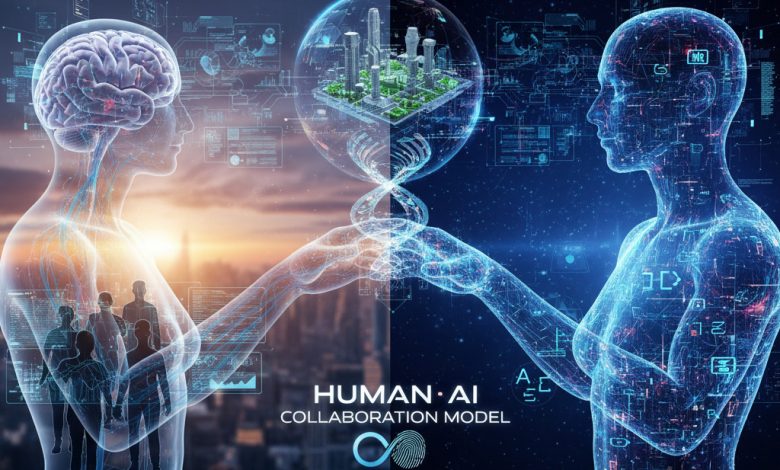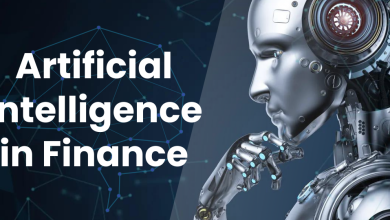
Introduction: The Next Phase of AI in Business
For years, conversations around Artificial Intelligence (AI) have focused on automation and efficiency, where machines replace repetitive human tasks and streamline operations. However, the true promise of AI extends far beyond automation. It lies in collaboration, a partnership in which humans and intelligent systems work together, combining the best of both worlds where human creativity, empathy, and contextual understanding with AI’s speed, scale, and precision exist.
This shift from humans versus machines to humans working with machines is quietly transforming how businesses operate, innovate, and make decisions.
From Automation to Augmentation: The Rise of AI Collaboration
In its early stages, AI adoption in enterprises primarily focused on improving efficiency. Chatbots replaced customer support teams, algorithms processed invoices faster than humans, and machine learning models predicted customer churn with impressive accuracy.
Yet, in many organizations, AI operated in isolation, disconnecting from the human experiences that truly drive business value.
The next evolution is known as Augmented Intelligence. This approach focuses not on replacing people but on amplifying their abilities.
- In healthcare, for example, AI can analyze thousands of medical scans within seconds, but a doctor’s expertise remains essential to interpret the results and communicate with patients.
- In finance, AI can detect anomalies in real time, while human analysts apply strategic thinking to make informed investment decisions.
- In customer service, AI assistants manage basic queries, while human agents handle complex or emotionally charged interactions.
In every case, AI performs heavy lifting, allowing people to focus on higher-value work such as creative problem-solving, decision-making, and building relationships. That is where true transformation begins.
Why Human AI Collaboration Outperforms Automation
Automation brings speed and precision but lacks adaptability and emotional intelligence. Collaboration, on the other hand, blends data-driven accuracy with human insight and context.
Consider the manufacturing industry, for an example. Predictive maintenance algorithms can identify potential equipment failures with remarkable accuracy. However, it is the engineer who decides whether to act immediately or delay maintenance based on business priorities.
In this example, AI provides information, while humans provide judgment.
This balance of insight and wisdom defines the Human AI Collaboration Model, where AI acts not as a decision maker but as a reliable decision partner.
Building a Framework for Hybrid Intelligence
To create a successful partnership between humans and AI, organizations need a well-defined framework that integrates technology with people and processes.
Through our work with enterprise clients, we have identified five key pillars that define successful human-AI ecosystems.
- Purpose Alignment:
Clearly define the reason for adopting AI. The objective should be to improve decisions, enhance customer experience, and achieve better outcomes rather than replace human roles. - Data and Context Integration:
AI depends on high-quality data, while humans provide the ethical, emotional, and contextual insights that data alone cannot capture. - Transparent Collaboration:
Employees should understand when they are interacting with AI, how it influences decisions, and why certain outcomes occur. Clarity creates trust. - Continuous Learning Loop:
Collaboration should evolve continuously. AI systems must learn from human input, and humans must adapt based on AI insights to create a feedback loop of shared learning. - Ethical Oversight:
Governance should ensure that AI delivers outcomes responsibly. Fairness, accountability, and transparency must be non-negotiable.
When these elements align, AI stops being a technology project and becomes an integral part of the organization’s long-term strategy and culture.
From AI Pilots to Scalable Enterprise Partnerships
Many organizations are caught in what can be described as the “AI pilot trap.” They run small-scale proof-of-concept initiatives that show promise but fail to scale across the organization.
The core reason is mindset. They treat AI as a one-time project instead of viewing it as a long-term partnership.
Real transformation begins when leaders shift their focus from asking whether AI can perform a task to asking how AI and people can achieve better results together.
Let me include few additional examples as below in different industries
- Retail: AI analyzes customer buying trends, while human merchandisers decide which products will resonate emotionally with consumers.
- Supply Chain: AI predicts delivery disruptions, while managers make trade-offs between cost, time, and relationships.
- Human Resources: AI screens resume efficiently, while hiring managers use emotional intelligence to assess cultural fit.
When organizations embrace AI as a collaborative partner, they achieve not only greater productivity but also higher creativity, resilience, and strategic agility.
Challenges in Building Human AI Collaboration
While the benefits of Human AI Collaboration are clear, organizations face several practical and cultural challenges in adopting this model. Highlighting below are some of the key challenges
- Building Trust:
Employees often fear that AI will replace them. Transparent communication and inclusive change management can help position AI as a co-worker rather than a threat. - Bridging the Skills Gap:
As AI evolves, employees must be reskilled to understand how AI supports their work both technically and strategically. - Maintaining Ethical Integrity:
AI systems can sometimes reinforce bias or make unclear decisions. AI can hallucinate. Investing in explainable AI and maintaining human oversight is essential. - Driving Cultural Change:
Transforming company culture is often harder than implementing new technology. Leaders must model collaborative behavior by integrating AI into their own workflows.
Organizations that confront these challenges directly will build both stronger AI systems and more adaptable human teams.
Let us further look into a few Real-World Examples of Human AI Collaboration
Healthcare: AI-Assisted Diagnosis
AI-driven diagnostic systems can detect early signs of diseases such as cancer and heart conditions with incredible precision. Human doctors interpret these findings, apply clinical judgment, and decide the next course of treatment. Together, they improve accuracy and outcomes.
Finance: Smarter Investments
AI models simulate market scenarios and assess portfolio risks, while financial experts apply ethics, experience, and intuition to finalize investment strategies. This combination enhances both speed and decision quality.
Customer Experience: Combining Empathy with Scale
AI-powered platforms handle millions of customer interactions efficiently. Human agents step in during sensitive or emotional conversations, ensuring empathy and trust remain intact.
Manufacturing: Predictive and Practical Maintenance
AI predicts potential machine failures, while engineers make informed decisions about repair timing, balancing operational uptime with safety and cost.
Each of these examples reinforces one principle and that is AI enhances human potential rather than replacing it.
The Human Edge in the Age of AI
Contrary to common belief, AI does not limit creativity or leadership. It actually strengthens them. By automating repetitive and data-heavy work, AI frees people to focus on what humans do best. AI allows humans to think strategically, innovate, and connect emotionally.
Consider a marketing team where AI handles performance analytics while humans create powerful storytelling campaigns. Or a logistics firm where AI manages real-time route optimization while human leaders build relationships with partners and clients. This is not a future scenario. The marriage between AI and human is already happening today.
Leadership in the Era of AI Collaboration
For business leaders, adopting AI collaboration is not just about introducing technology. It is about driving cultural transformation.
To lead effectively in this new era, executives should try to nurture the follow
- Encourage curiosity and experimentation with AI tools.
- Promote cross-functional collaboration between data experts and business leaders.
- Recognize and reward employees who use AI creatively to improve results.
- Ensure that governance, ethics, and inclusivity are at the core of all AI initiatives.
The most successful enterprises will not be those that use AI the most, but those that collaborate with AI the best.
Looking Ahead: The Future of Symbiotic Intelligence
We are entering an era of symbiotic intelligence where humans and machines learn, adapt, and grow together.
The question is no longer whether AI will change the way we work. That change has already begun. The real question is how we can make this relationship meaningful, ethical, and impactful.
History shows that technology reshapes industries, but human creativity determines how far we progress. The enterprises of the future will see AI not as a cost-reduction tool but as a co-pilot for growth, innovation, and human progress.
Final Thoughts
As in every technical revolution in the past this time also, AI is not here to replace humanity. It is here to redefine how we work and think. AI is now expanding our cognitive and creative potential. The Human AI Collaboration Model represents a fundamental reimagining of how we define intelligence, success, and work itself.
Those who embrace this transformation early, guided by empathy, ethics, and openness, will shape the next generation of enterprise excellence.




